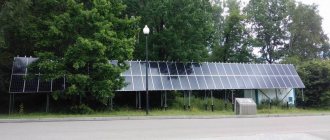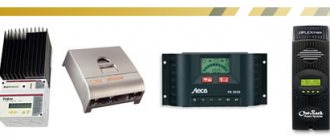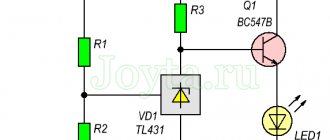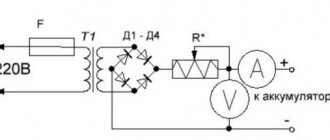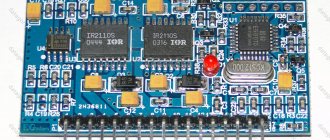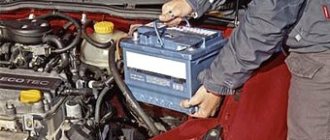A charge controller for a solar battery, designed for 12, 24 or 48 volts, is the most important element of any solar power plant that uses a battery. Its main tasks are to ensure an uninterrupted supply of current to the network while simultaneously managing the battery charge level. On the modern market you can buy various types of controllers that differ in functionality, reliability and price. Structurally, the device can be made as a separate element of the system or built into a power supply or inverter.
Product categories
- EPSolar solar charge controllers MPPT (1)
- Goal Zero Folding Solar Panels (2)
- Li-ion UPS and battery (8)
- MPPT Charge Controllers (40) Delta solar charge controllers MPPT (5)
- EPSolar solar charge controllers MPPT (20)
- I-Panda Solar Charge Controllers MPPT (3)
- JUTA solar charge controllers MPPT (3)
- Schneider Electric solar charge controllers MPPT (2)
- SRNE solar charge controllers MPPT (7)
- Stark Country INV (4)
- Chilwee batteries (30) DZM series (10)
- Series A (8)
- Carbon CDG Series (4)
- FT Series (10)
- Series MM (13)
- OP Series (8)
- GL Series (4)
- GPL Series (7)
- GST Series (3)
- VOSTOK PRO Series CK (15)
- Active charge equalizers (3)
- Ecovolt series Solar battery inverters (3)
- Boilers "Drazice" with enamel coating (4)
- BRAUDER hybrid inverters (1)
- Sets of autonomous two-way traffic lights T 7.1 (38)
- Autonomous solar power plants (6)
- AcmePower inverters (14)
- AcmePower inverters (7)
- AcmePower UPS (8)
- MPPT Charge Controllers (2)
- Delta BST Monocrystalline Solar Panels (9)
- Delta BST Polycrystalline Solar Panels (6)
- Size II (4)
- IP65 Weatherproof Electrical Box for Pole and Wall Mounting (1)
- GoodWe grid inverters (3)
- LED light bar (1)
- Boilers and buffer tanks (2)
- Flexible solar panels (2)
- EcoFlow Folding Solar Panels (1)
- Infrared gas heater Ballu BIGH (6)
- Delta solar charge controllers "PWM" (8)
- Inverters Energy UPS PRO (7)
Types of controllers for solar panels
Ensuring maximum efficiency of solar power plants, which are forced to use either the panels themselves or batteries as an energy source, is a technologically complex and expensive task. For this reason, the choice of controller for the system is made based on the most important factors. These are the potential performance of the SPP, the importance of ensuring maximum efficiency and the expected profit. As a result, you have to compromise, choosing one of five possible options.
We offer the most popular and efficient controllers for solar power plants of various capacities:
- PWM (PWM).
The PWM (Pulse-Width Modulation) solar panel controller is capable of reliably modulating the current value. The result is the ability to recharge the battery completely, albeit over a fairly long period of time. The price of these models for small private power plants is quite reasonable. - MPRT.
It is recommended for owners of stations with sufficiently high power to buy a charge controller for solar panels of the MPPT (Maximum Power Point Tracking) type. In this case, the considerable cost of such a regulator will quickly pay for itself, since it is 30-35% more efficient than any competitor. This is achieved through the operation of a complex computer algorithm, in real time, constantly calculating and delivering current of optimal strength and voltage.
Operating principle of solar controller and battery charging stage:
- Accumulation (Bulk) – charging with maximum current until the specified voltage value is reached at the stage – absorption, in which case the battery becomes 80% infected;
- Absorption or absorption (Absorbtion) is an absorbing charge in which the charge controller maintains the voltage, reducing the charging current until the battery is fully charged;
- Maintenance charge or equilibrium (Float) - reducing the voltage below the absorption stage value to prevent overheating or gas formation;
- Balancing charge or equalization (Equalize) - used only for batteries with liquid electrolyte, during which a higher voltage is applied, air bubbles form on the plates, rising to the top mix the electrolyte. This process is accompanied by the formation of hydrogen and oxygen, which increases its explosiveness. To ensure safe operation of this device, it is sufficient to provide ventilation and eliminate all sources of ignition. This mode cannot be used for sealed batteries.
Backup power supply kit 2000W inverter power, 5.2 kWh energy reserve
0 less than 5
(0)
Article: R-01
₽108,900.00 Add to cart
Add to favorites
Compare
Additional Controller Features
Depending on the functionality of the selected model, solar battery charge controllers are capable of performing the following useful operations:
- provide detailed information about the most important current parameters of the system - battery charge level, current, voltage, output power, etc.;
- store and provide statistical data for various periods - for example, the volume of electricity supplied to the network by day, week, month, etc.;
- regulate the load according to the mode set by the timer or automatically depending on external factors (sunset, turning on street lights);
- send information to an external source, such as a laptop, via Wi-Fi;
- automatically switch the load to the desired source and disconnect the batteries when charging is complete.
EP3200 3500-24 LCD screen pure sine with charger
0 less than 5
(0)
Article: EP3200-3500-24
₽33,440.00 Add to cart
Add to favorites
Compare
Solar single-phase network inverter Sofar 4.6KTLM-G2 4600VA (2 MPPT)
0 less than 5
(0)
Article: 4.6KTLM-G2
₽43,428.00 Add to cart
Add to favorites
Compare
Testing
As expected, there were no problems with the discharge.
The battery charge was enough to charge the tablet, the LED strip was also on, and at a threshold voltage of 10V, the strip went out - the controller turned off the load so as not to discharge the battery below the specified threshold. But with the charge, everything went wrong. At first everything was fine, and the maximum power according to the wattmeter was about 50W, which is quite good. But towards the end of the charge, the tape connected as a load began to flicker strongly. The reason is clear even without an oscilloscope - the two BMSs are not very friendly with each other. As soon as the voltage on one of the cells reaches the threshold, the BMS turns off the battery, which causes both the load and the controller to turn off, then the process repeats. And considering that the threshold voltages are already set in the controller, the second protection board is essentially not needed.
I had to return to plan “B” - install only a balancing board on the battery, leaving charge management to the controller. The 3S balance board looks like this:
The bonus of this balancer is that it is 2 times cheaper.
The design turned out to be even simpler and more beautiful - the balancer took its “rightful” place on the battery balancing connector, the battery is connected to the controller via the power connector. Everything together looks something like this:
There were no more surprises. When the voltage on the battery rose to 12.5V, the power consumed from the panels dropped to almost zero and the voltage increased to the “no-load” maximum (22V), i.e. the charge no longer flows.
The voltage on 3 battery cells at the end of the charge was 4.16V, 4.16V and 4.16V, which gives a total of 12.48V; there are no complaints about the charge control or the balancer.

